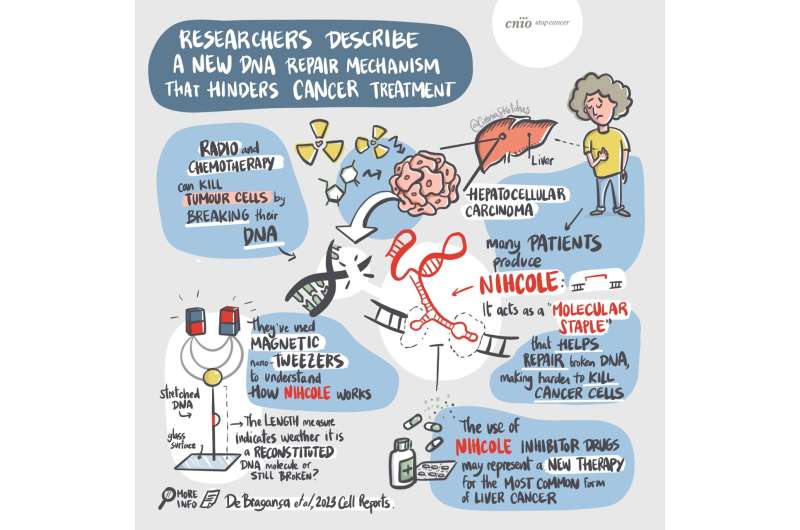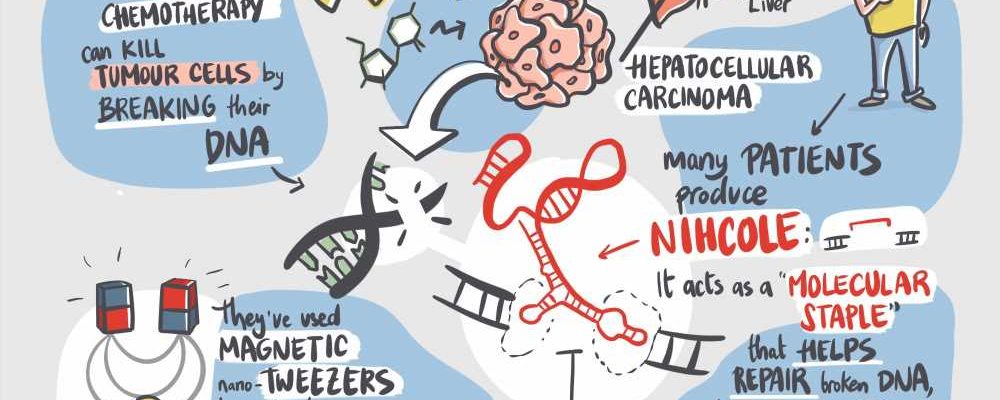One of the causes of aggressive liver cancer discovered: A ‘molecular staple’ that helps repair broken DNA

Error-correcting mechanisms are very important for cells, because with all the cellular activity constantly going on, malfunctions arise all the time. But when it comes to killing cancer cells, it is in the cells’ best interest to induce errors. Radiotherapy and chemotherapy can cause cellular defects by breaking the DNA of the cells. However, some tumor cells have an exceptionally efficient DNA repair machinery that allows them to evade cancer treatment.
In a paper published in Cell Reports, Óscar Llorca of the CNIO, Fernando Moreno-Herrero of the CNB and Puri Fortes of the CIMA-University of Navarra have now revealed the workings of one of these extraordinary repair systems: a molecular staple that has been shown in action for the first time using a new nanotechnology technique.
In liver cancer with the worst prognosis
A few years ago, a team led by Puri Fortes team discovered that about half of patients with hepatocellular carcinoma (the most common type of liver cancer) produce an RNA molecule called NIHCOLE, which is found mainly in the most aggressive tumors and is associated with a poor prognosis. Fortes, Llorca and Moreno-Herrero concluded that NIHCOLE is very effective at helping repair broken DNA, which is why radiotherapy is less effective in tumors where it is present. By eliminating NIHCOLE, cancer cells treated with radiotherapy die more easily.
However, the molecular mechanism by which NIHCOLE facilitates the repair of DNA breaks was not known. The paper just published in Cell Reports explains this: NIHCOLE forms a bridge that binds the broken DNA fragments together.
“NIHCOLE interacts simultaneously with proteins that recognize the two ends of a fragmented DNA, as if stapling them together,” explain Llorca and Moreno-Herrero.
Understanding this mechanism may help in the development of strategies to combat liver cancers with the worst prognosis. “The use of NIHCOLE inhibitor drugs may represent a new therapy for the most common form of liver cancer,” the researchers say.
Magnetic nano-tweezers for stretching DNA
To understand how NIHCOLE works, Fernando Moreno-Herrero’s group has used magnetic tweezers, a nanotechnology technique that allows the physical properties of individual molecules to be studied.
Researchers have designed a DNA molecule that mimics broken DNA, allowing them to detect the junction between the two fragmented ends. First, they attach a tiny magnetic bead, on the scale of a thousandth of a millimeter, to one end of the DNA, and then use magnetic nano-tweezers to pull on that end. The length of the stretched DNA indicates whether it is a reconstituted DNA molecule, in which the broken ends of the DNA have been joined together, or whether it is still broken.
For the authors of the Cell Reports paper, these data show that NIHCOLE “confers advantages on tumor cells by helping them to repair DNA breaks, thereby sustaining the malignant proliferation of cancer cells despite the accumulation of DNA damage resulting from the stress of cell division itself.”
‘Junk DNA’ that is no longer junk
NIHCOLE is not a protein synthesized by a gene, but an RNA molecule. It is part of what biologists dubbed junk DNA two decades ago when the human genome was being sequenced. At the time, they mistakenly believed that this DNA was useless.
Llorca explains, “One of the central dogmas of biology is that the information contained in each gene, in DNA, is translated into proteins. So scientists were stunned when they discovered that only 2% of our DNA contained genes; what was the rest of our genome for? It is unthinkable that 98% of the genome is junk, useless DNA. In the last decade it has been shown that part of this dark genome produces very long RNA molecules, some of which have a prevalent function in cancer.”
NIHCOLE is one of these long RNA molecules, the existence and function of which have only recently been discovered to such an extent that biologists are still amazed. It is also surprising that only a small piece of NIHCOLE is required for it to act as a molecular staple.
“This would allow the development of drugs that block or distort this structure, and thus improve the efficacy of radiotherapy or chemotherapy in cancer patients,” say the authors of the paper.
More information:
Sara De Bragança et al, APLF and long non-coding RNA NIHCOLE promote stable DNA synapsis in non-homologous end joining, Cell Reports (2022). DOI: 10.1016/j.celrep.2022.111917
Journal information:
Cell Reports
Source: Read Full Article
